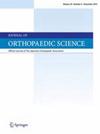青少年特发性脊柱侧凸患者背痛的特点:矫正手术候选者的考虑因素
IF 1.5
4区 医学
Q3 ORTHOPEDICS
引用次数: 0
摘要
背景以往的研究表明,青少年背部疼痛的点患病率为12%至33%,终生患病率为28%至51%。然而,关于青少年特发性脊柱侧弯症(AIS)患者背痛的研究却很少,而且这些研究都有很大的局限性,包括缺乏对比对照和有关脊柱侧弯畸形或疼痛部位的详细信息。本研究旨在确定患有AIS的青少年是否会在特定区域出现背痛。方法这项回顾性病例对照研究纳入了189名患有AIS的女性青少年,她们在2008年至2020年间接受了矫正融合手术。术前使用脊柱侧凸研究学会结果工具-22(SRS-22)进行背痛和健康相关生活质量(HRQOL)问卷调查。结果主要胸椎和胸腰椎/腰椎曲线的平均Cobb角分别为51.4 ± 15.3°和40.4 ± 12.9°。与健康对照组相比,背痛的特征包括更高的点患病率(25.9%)和终生患病率(64.6%)。背痛青少年在 SRS-22 疼痛和心理健康领域的得分较低。患有严重胸椎AIS的青少年与患有严重胸腰/腰椎AIS的青少年相比,右背中上部的背痛更严重。右肩胛骨周围的疼痛与带有肋骨驼峰畸形的右胸大弯之间存在关系。本文章由计算机程序翻译,如有差异,请以英文原文为准。
Characteristics of back pain in patients with adolescent idiopathic scoliosis: Considerations in candidates for corrective surgery
Background
Previous studies have demonstrated that the point prevalence of back pain ranges from 12 % to 33 % and that the lifetime prevalence of back pain ranges from 28 % to 51 % in adolescents. However, few studies on back pain in patients with Adolescent idiopathic scoliosis (AIS) have been conducted, and these studies had significant limitations, including a lack of comparative controls and detailed information about scoliotic deformity or pain location. This study aimed to determine whether adolescents with AIS experience back pain in specific regions.
Methods
This retrospective case-control study included 189 female adolescents with AIS who underwent corrective fusion from 2008 to 2020. Questionnaires on back pain and health-related quality of life (HRQOL) using the Scoliosis Research Society Outcomes Instrument-22 (SRS-22) were conducted preoperatively. The control group included 2909 general female adolescents.
Results
The mean Cobb angles in the main thoracic and thoracolumbar/lumbar curves were 51.4 ± 15.3° and 40.4 ± 12.9°. Back pain characteristics included higher point prevalence (25.9 %) and lifetime prevalence (64.6 %) compared to healthy controls. Adolescents with back pain showed lower scores in the pain and mental health domains of the SRS-22. Adolescents with major thoracic AIS showed more back pain in the upper and middle right back compared to adolescents with major thoracolumbar/lumbar AIS.
Conclusion
The point and lifetime prevalence of back pain were definitely higher in patients with AIS, which affected their HRQOL. There was a relationship between pain around the right scapula and the right major thoracic curve with a rib hump deformity.
求助全文
通过发布文献求助,成功后即可免费获取论文全文。
去求助
来源期刊

Journal of Orthopaedic Science
医学-整形外科
CiteScore
3.00
自引率
0.00%
发文量
290
审稿时长
90 days
期刊介绍:
The Journal of Orthopaedic Science is the official peer-reviewed journal of the Japanese Orthopaedic Association. The journal publishes the latest researches and topical debates in all fields of clinical and experimental orthopaedics, including musculoskeletal medicine, sports medicine, locomotive syndrome, trauma, paediatrics, oncology and biomaterials, as well as basic researches.
 求助内容:
求助内容: 应助结果提醒方式:
应助结果提醒方式:


